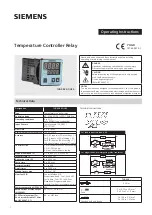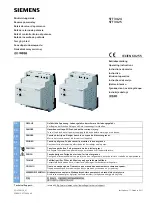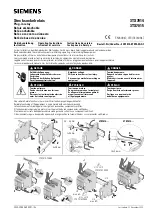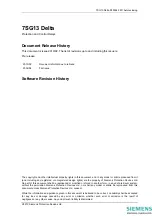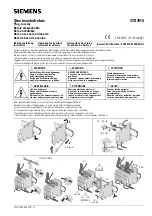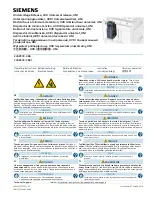
K2CM
12
Testing Method
■
Current Reverse-phase Detection Models
The operating characteristics listed in the table below are tested using the circuit shown on the right. Decide the number of conductor
passes through the holes of the current transformer in accordance with the operating current range of the Motor Protective Relay and by
referring to the current setting method described under
Operation, Setting, and Indication
.
* Balance the currents between phases by adjusting variable resistor R1.
** If a current equal to 600% of the set current value cannot be attained by adjusting the voltage regulator, increase the number of conductor passes
through the holes of the current transformer.
Test item
Test procedure
Operating value
Operating time
Over-
current
Inverse type
1.
Turn ON SW1.
2.
Turn ON SW2 to operate auxiliary relay Y.
3.
Gradually increase the current by adjusting the voltage
regulator. With inverse-type models, read the value of the
current when the overcurrent LED indicator blinks. With
instantaneous-type models, read the value when it lights
(continuously).*
4.
Turn OFF SW1 and SW2.
1.
Turn ON SW1 and SW2. Increase the current to 600% of
the set current value by adjusting the voltage regulator.
Turn OFF SW1 and SW2.**
2.
Turn ON SW1.
3.
Turn ON SW2 and read the position (i.e., time) of the
pointer of cycle counter CC when CC is stopped by the
operation of the K2CM. The read time is the operating time
for inverse-type models and the lock time of the instanta-
neous-type models.
4.
Turn OFF SW1 and SW2.
Instantaneous
type
1.
Turn ON SW1 and SW2. Increase the current to 100% of
the set current value by adjusting the voltage regulator.
Turn OFF SW1 and SW2.
2.
Turn ON SW1 and SW2 again and wait 2 seconds mini-
mum.
3.
Using the voltage regulator, abruptly increase the current
to 140% of the set current value. Confirm that the K2CM
performs instantaneous operation.
4.
Turn OFF SW1 and SW2.
Open-phase
1.
Open (disconnect) any one of the input phases for the cur-
rent transformer.
2.
Turn ON SW1 and SW2. Gradually increase the current by
adjusting the voltage regulator.
3.
Confirm that the K2CM operates at a current no greater
than 85% of the set current value and that, at this current,
the trip indicator is orange and the open-phase LED indica-
tor lights.
4.
Turn OFF SW1 and SW2.
1.
Open (disconnect) any one of the input phases for the cur-
rent transformer.
2.
Turn ON SW1 and SW2. Increase the currents of the other
two phases to 115% of the set current value by adjusting
the voltage regulator. Turn OFF SW1 and SW2 temporarily.
3.
Turn ON SW1 and SW2 again. Read the position (i.e.,
time) of the pointer of cycle counter CC when CC is
stopped by the operation of the K2CM.
4.
Turn OFF SW1 and SW2.
Reverse-phase
1.
Interchange any two phases at a position closer to the
power supply than the current transformer. (In the above
figure, phases U and V are interchanged as shown by the
dotted lines.)
2.
Turn ON SW1 and SW2. Decrease the current to 50% of
the set current value by adjusting the voltage regulator.
Then turn OFF SW1 and SW2 temporarily.
3.
Turn ON SW1 and SW2 again. Confirm that the K2CM
operates, the trip indicator is orange, and that the reverse-
phase LED lights.
4.
Turn OFF SW1 and SW2.
1.
Interchange any two phases at a position closer to the
power supply than the current transformer. (In the above
figure, phases U and V are exchanged as shown by the
dotted lines.)
2.
Turn ON SW1 and SW2. Increase the current to 100% of
the set current value by adjusting the voltage regulator.
Then turn OFF SW1 and SW2 temporarily.
3.
Turn ON SW1 and SW2 again. Read the position (i.e.,
time) of the pointer of cycle counter CC when CC is
stopped by the operation of the K2CM.
4.
Turn OFF SW1 and SW2.
R
1
R
1
c
1
s
1
s
2
c
2
b
2
a
1
R
2
Y
U
V
W
S
W
1
S
W
2
CC
100
V
C
K2CM Motor Protecti
v
e Relay
3
φ
SD: Three-phase
v
oltage reg
u
lator (5 to 15 A)
A:
AC ammeter (5 A)
V
: AC
v
oltmeter (300
V
)
CC: Cycle
co
u
nter
Y: A
u
xiliary relay (15 A)
R1:
V
aria
b
le resistor (50
Ω
, 400
W
+ 400
W
)
R
2
: Fixed
resistor
(50
Ω
, 400
W
+ 400
W
)
S
W
1
: Knife s
w
itch (3-phase)
S
W
2
: Toggle s
w
itch
200
V
50/60 Hz
(3-phase)
100
V
AC
50/60Hz
3
φ
SD
±
Minim
u
m set time is 2 s.





















